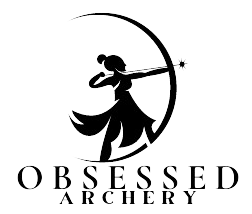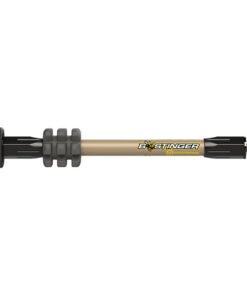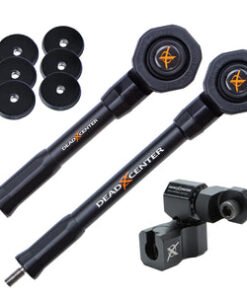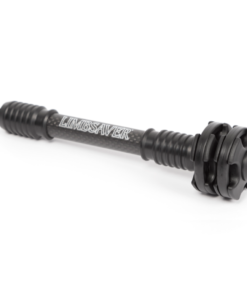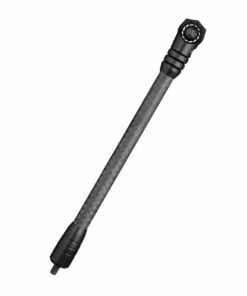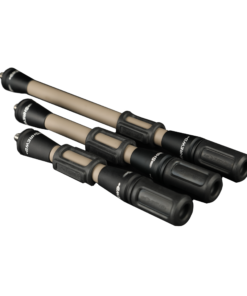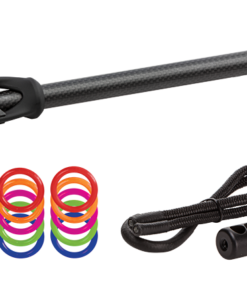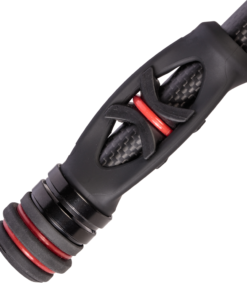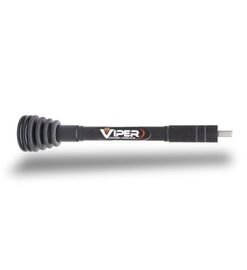Bow Stabilizer
In the silence of the archery range, a bowstring snaps forward, and milliseconds later, an arrow hits its target—an outcome where precision matters most. Archery, an ancient practice, has evolved extensively, with modern equipment such as the bow stabilizer enhancing an archer’s skill. Understanding these advancements offers a glimpse into how technology meets tradition, refining an arrow’s flight to perfection.
At the heart of archery’s technological leap is the bow stabilizer, a seemingly simple accessory that greatly influences an archer’s performance. But what is this device, and how can it transform a good shot into a great one? The answers lie in the fundamental mechanics of archery and the stabilizer’s role in mitigating unwanted movement and vibration.
Embark on a journey through the world of bow stabilizers, discovering the varied types, top brands, and essential tips for choosing, installing, and maintaining this critical archery component. The following article unravels the complexities of bow stabilizers, ensuring every archer can make an informed decision to improve their aim and consistency, whether for sport or hunting.
Benefits of Using a Bow Stabilizer
When venturing into the realm of archery, whether it be for the thrill of 3D target shooting or the tenacity of hunting bows, the role of stabilizers cannot be overstated. A bow stabilizer is more than a mere accessory; it is an integral part of the archer’s toolkit, crafted to enhance stability, reduce bow torque, and ultimately refine accuracy. By diffusing vibrations and balancing the bow, stabilizers like Bee Stinger and Cutter Stabilizers provide a noticeable upgrade to one’s shooting experience.
Improved Stability
With some stabilizers offering up to several oz of weight, the addition of this extra weight is pivotal in crafting a steady shooting platform. The precision-engineered stabilizer bars are strategically designed to absorb shock while holding the bow steadier during aiming, which results in less bow dip and a more balanced feel—qualities that Trophy Ridge and other high-end stabilizers exhibit through their meticulously balanced designs. Coupled with the optimal placement of mass weight, this translates to smoother shots and a solidified sense of control that underpins a hunter’s confidence or a target shooter’s focus. Even everyday apparel such as wrist slings complement the stabilizer’s role by offering additional support and decreasing the likelihood of bow drop.
Reduced Bow Torque
Torque, the arch-nemesis of precision, can easily disrupt an otherwise perfect compound bow setup. Stabilizer bars with smart weight placements combat the adversary that is lateral movement. Archery manufacturers have taken note, and products such as Bear Archery’s stabilizers are often engineered to fend off bow torque by introducing features like harmonics dampeners. These enhancements not only fortify the bow against torque but also contribute to a Dovetail mount’s ability to maintain an optimal sight picture without the hindrance of unnecessary movement.
Enhanced Accuracy
It’s clear that stabilizers have a symbiotic relationship with accuracy—increasing rotational inertia to resist movement, reducing vibration for an unshaken aim, and maintaining a poised composure during the arrow launch. The result is a formula that defines the path to near-perfect shooting regularity. Arrow Tubes & Cases, Factory fletch arrows, and Broadheads & Specialty Points work in consonance with stabilizers to guarantee flight consistency. Archers dedicated to accuracy trust stalwarts such as Gold Tip and Black Eagle to deliver stabilizer systems that complement their meticulous preparation. Driven by data, the improved accuracy facilitated by stabilizers can sharply ratchet up an archer’s proficiency—be it in the calm of an indoor range picture or the unpredictable environment of the whitetail woods.
Implementing accessories like a bow stabilizer may seem like a small step, but it’s a giant leap in mastering the artistry of archery. Whether for competition, hunting, or family fun, stabilizers undeniably play a pivotal role in elevating the archer’s performance. Special promotions on hunting accessories often highlight the latest stabilizers, assuring that both novice and seasoned archers have access to this indispensable tool. From 3D target practice to hunting bars in the wilderness, a bow stabilizer is not just an option—it’s a critical component of the archer’s success story.
Understanding Stabilizers
Understanding Stabilizers
In the quest to enhance archery performance, stabilizers emerge as a critical component for both competitive target shooters and hunters. These devices are not just mere appendages but are instrumental in reducing bow vibration and assisting in maintaining a steady hold during shooting. Long recognized by the experts in the field, including renowned archery manufacturers, the integration of stabilizers like those from Bee Stinger and Cutter Stabilizers has fundamentally changed the archer’s experience.
What are Stabilizers?
Stabilizers are specialized accessories designed to serve two overarching functions in the archery world: the reduction of vibration and the improvement of bow steadiness. As an archer draws and releases an arrow, minute vibrations travel through the bow, which can not only be uncomfortable but can also affect accuracy. Stabilizers are crafted to absorb and minimize these vibrations, leading to a smoother shooting process. Concurrently, they provide a counterbalance to the bow, which can make holding the bow steadier during the aim a simpler feat. This is achieved more efficiently with longer stabilizers, which allow for greater stabilization with comparatively less weight. Additionally, stabilizers can correct imbalances in bow weight distribution, particularly when a bow-mounted quiver is not in use. With options from hunting stabilizers designed for the rugged demands of the field to sleek, precision-oriented models for 3D target competition, stabilizers can be adapted to suit various archery disciplines.
How do Stabilizers Work?
The mechanics behind a stabilizer’s functionality are straightforward yet profound in their impact. By attaching weight below the hand, stabilizers resist the naturally occurring hand torque that happens during an arrow’s release. This resistance not only steadies the bow but aligns it more consistently for subsequent shots. The stabilizer’s ability to absorb shock comes from its composition and design, which often include internal vibration dampening systems. Advanced models might feature micro diameter carbon fiber tubes, optimized for both strength and stability. These tubes, sometimes paired with weight couplers at the far end, maximize the bow’s resistance to rotation and enable the stabilizer to perform at its best.
Adjustable weights are common in high-quality stabilizers, granting archers the ability to tailor the bow’s balance to their specific shooting style or preferences. The additional mass weight at the front end of the bow serves a dual purpose: it reduces forward tipping, allowing for a more level aim, and contributes to noise dampening by curtailing vibrations. When selecting the right bow stabilizer, important considerations include the length, which influences overall stability and maneuverability, and the total oz of weight, which can determine the stabilizer’s effectiveness and the archer’s comfort during extended use.
Thus, whether aiming for the perfect compound bow setup for hunting in the whitetail woods or striving for a top score in an indoor 3D target competition, the bow stabilizer is an essential part of achieving optimal performance. It’s not enough to have Factory fletch arrows or top-tier Broadheads & Specialty Points; the bow must be balanced and vibration-free. That’s where the nuanced selection and use of the right stabilizer come into play.
Types of Bow Stabilizers
Bow stabilizers are indispensable accessories for both novice and experienced archers, optimizing performance by enhancing balance and reducing vibrations during a shot. Each type of stabilizer caters to specific needs, be it for competitive shooting or bow hunting. The primary types include fixed, adjustable, weighted, and dampening stabilizers, each with unique features to suit different scenarios and preferences.
Fixed Stabilizers
Fixed stabilizers are a standard choice for many archers due to their simplicity and effectiveness. They work by firmly attaching to the bow and providing a consistent counterbalance, which is essential for optimal balance and shot execution. These stabilizers often incorporate advanced technology—like Mathews’ harmonic dampener—which profoundly absorbs the bow’s vibration, contributing to a smoother and more accurate release. While they don’t offer the same level of customization as their adjustable counterparts, fixed stabilizers in various lengths allow archers to find a suitable match for their setup and shooting style.
Adjustable Stabilizers
Adjustable stabilizers stand out for their versatility and customization. These stabilizers feature a modular weight system, where individual weights can be linked together and secured with an end cap equipped with a harmonic dampener. The ease of customizing the stabilizer’s mass allows archers to fine-tune their bow’s weight distribution, improving balance and reducing the forward tipping tendency. Additionally, the built-in dampener efficiently soaks up any lingering vibrations, ensuring comfort and accuracy in each shot. The convenience of adjusting weight on the fly makes these stabilizers a favorite among archers seeking precision and adaptability.
Weighted Stabilizers
Weighted stabilizers provide a solution to the challenge of front mass weight presented by modern hunting bows. Their design helps to counteract this weight, promoting better overall balance and significantly improving shooting technique. The sidebar stabilizer is a variant of the weighted type, extending sideways from the bow’s riser to counteract lateral movement and enhance stability—a boon for archers dealing with consistent directional drifts in their shots. With cutting-edge designs, such as the wind-friendly models from Mathews that allow air to pass through and feature a variable weight system with harmonic dampeners, weighted stabilizers cater to the need for balance while diminishing vibration and bow torque.
Dampening Stabilizers
Dampening stabilizers prioritize reduction in both vibration and noise, making them a considerable choice for hunters who value stealth. These stabilizers are available in different materials, from aluminum and carbon to rubber, each bringing its own set of advantages in terms of durability, vibration dampening, and noise reduction. While their primary function is to ensure a steady hold by lessening bow vibration, the length and weight of dampening stabilizers are critical factors that affect overall effectiveness. Longer bars enable stabilization with less added mass, facilitating ease of use. However, heavier stabilizers, while offering increased steadiness, may cause fatigue if not carefully chosen to match the archer’s physical capability and shooting durations. Selecting the right dampening stabilizer involves balancing these elements to achieve an individualized and comfortable shooting experience.
Choosing the Right Bow Stabilizer
Choosing the right bow stabilizer is a critical decision for both target archers and bowhunters alike. The goal is to achieve optimal balance for the bow at full draw just before the arrow is released. A well-selected stabilizer will enhance stability, reduce torque, and dampen vibration upon release, which can significantly improve shot accuracy and comfort.
Considerations for Hunting Stabilizers
When selecting a hunting stabilizer, it’s important to find a balance between enhanced stability and manageable weight. The chosen stabilizer should provide a steady aim without adding burdensome weight to the bow, which is especially vital for hunters who may have to hold their bows drawn for extended periods. Experimentation with various lengths and weights is key to finding a setup that feels right and complements the specific dynamics of the bow and archer. Hunting stabilizers, typically ranging from 10 to 12 inches, are popular for their improved rotational inertia, which allows for stability with less counterweight compared to shorter options.
Brands like Bee Stinger, CBE, Axion, and Mathews are recognized for producing quality hunting stabilizers that balance the bow efficiently during a full draw. An optimal setup may include fine-tuning the length, weight, and positioning of both the front and backbar stabilizers. This customization ensures the weight is distributed appropriately, achieving the perfect counterbalance for minimal movement upon arrow release.
Considerations for Target Archery Stabilizers
Target archery stabilizers are generally longer, typically ranging from 28 to 33 inches, which provides enhanced leverage and stability while aiming. To maximize their effectiveness, the stabilizer should exceed the distance between the riser and the outside edge of the limb pockets by at least 2 inches. Anything shorter may not contribute as effectively to accuracy but can still offer significant vibration reduction.
While side rods are not a necessity, they can prove beneficial in fine-tuning bow balance, aiding in the precision of the shot. Twin stabilizers can also provide excellent stability in multiple directions, which is why they are a favorite among seasoned target archers. The ultimate setup will maximally stabilize the bow without overcomplicating the equipment or affecting the archer’s focus.
Choosing the Right Length
When considering stabilizer length, an 8-inch stabilizer is the generally accepted minimum for functional use, but 10-12 inches can provide improved balance and stability. Although longer stabilizers offer greater stability, they can be less convenient for hunting situations where maneuverability is key. It’s crucial to weigh the benefits of improved stability against the potential hindrance of a longer stabilizer based on individual shooting styles and intended usage.
Balancing the Weight
Properly balancing the weight of a stabilizer is paramount for achieving optimal stability and accuracy. By adjusting the weight of the stabilizer, an archer can offset bow torque and maintain a consistent hold during aiming. Counterweights can alter the balance and position of the sight pin, enhancing the archer’s focus on the target, reducing hand movement, and promoting a steady aim. Fine-tuning the stabilizer’s weight distribution requires a balance between stability and comfort; it should minimize vibration and noise without causing fatigue or discomfort during use.
Top Bow Stabilizer Brands
Archery requires a unique blend of skill, precision, and the right equipment to achieve optimal performance. Among the essentials that contribute to a shooter’s success is a quality bow stabilizer. The market is filled with an array of brands, each promising to deliver the stability and vibration reduction that archers seek. Brands like Axcel, Shrewd, Dead Center, Bee Stinger, and Redline stand out, offering products that cater to various preferences and needs. The Axcel Antler Ridge 10-inch takes the top spot as the Best Overall stabilizer – its design featuring high-modulus carbon and a flax Kryptos Arc Dampener for eliminating vibration. The Shrewd Atlas is superb as the Best Siderod Mount stabilizer. For those looking for a Best Combo Pack, the Dead Center Dead Level Hunter Verge Lite Stabilizer Kit offers remarkable versatility. Bee Stinger comes in strong with the Microhex Counter Slide, crowned as the Best Single-Bar, Dual Purpose stabilizer. Lastly, the Redline RL-1 delivers as the Best Budget option, ensuring cost-conscious archers don’t compromise on stabilization.
Bee Stinger
Bee Stinger ensures that peak performance is within reach. Every stabilizer in their lineup is masterfully crafted to boost balance and stability, while simultaneously reducing shot vibration and bow torque. With standout series like MicroHex and the Hunter Series, Bee Stinger’s products have become synonymous with enhanced shot steadiness. Their solid construct allows archers to peaceably focus on their target rather than their gear, courtesy of the secure wedge design with a reliable locking bolt. The Microhex Counter Slide, in particular, offers ingenious adjustability that caters to the archer’s needs, functioning as both a front stabilizer and a side rod. Noteworthy is their dovetail mount feature, Countervail technology, and adjustable weight system, positioning Bee Stinger as an exemplary choice for bow stabilization.
Trophy Ridge
Trophy Ridge excels in providing archery accessories that not only supplement an archer’s setup but also enhance the overall shooting experience. Specializing in resonant vibration reduction, their stabilizers ensure a quieter, more controlled release. With an arsenal that includes sights, rests, stabilizers, quivers, and arrows, Trophy Ridge stays at the forefront of archery technology. As part of their comprehensive equipment lines, Trophy Ridge stabilizers exemplify innovation, showcasing features aimed at diminishing noise and vibration for a smoother, more precise shot.
Bear Archery
Bear Archery has established itself as a trusted name in the realms of hunting and target shooting through its diverse offering of bow stabilizers and accessories. Renowned for their Legend Series and mainline compound bows, Bear Archery extends this commitment to quality across their stabilizer range. They provide essential support gear, including sights, rests, quivers, and arrows, to service different bow variants with equal finesse. Commitment to quality and the archery community drives Bear Archery as a brand dedicated to supplying a full spectrum of equipment tailored for archery enthusiasts.
Doinker
Doinker is the brainchild of Bill Leven, stemming from an understanding of how weight distribution influences rotational resistance. Leven’s designs concentrate mass weight at the distal end of the stabilizer bar, optimizing the bow’s resistance to movement. By utilizing weighted couplers strategically positioned, Doinker Stabilizers create a shooting experience that leverages the laws of physics to assure steadfastness and accurate arrow flight. Archers benefit from the stability that Doinker’s meticulously engineered products deliver, reinforcing their ability to maintain consistency within the sport.
In creating content focused on bow stabilizers, it’s important to emphasize their purpose and design features, as well as to highlight the unique selling points of each brand. With the specific models mentioned above, potential customers gain insight into what distinguishes a product in a crowded market, allowing them to make informed decisions based on their archery goals and preferences.
Installing and Adjusting a Bow Stabilizer
Bow stabilizers play an indispensable role in fine-tuning the shooting experience. They are vital tools for archers looking to enhance their bow’s stability and improve accuracy. Added to the lower part of the bow to counterbalance torque, stabilizers come in different shapes, sizes, and weight configurations. Proper installation and adjustment are key to reaping the benefits they offer. Here, we delve into the steps and considerations for mounting a bow stabilizer and subsequently adjusting its weight and balance for tailored performance.
Mounting the Stabilizer
When attaching a stabilizer, the process, though straightforward, requires attention to detail to ensure precise balance. Start by identifying the stabilizer mounting hole on your bow’s riser. This hole is threaded and designed to accommodate the stabilization system. To begin, take the locking bolt and thread it through the long rod, then into this mounting point. Make sure the fit is snug and secure, with no play that could affect performance.
Modern stabilizers usually come with set screws on the rod ends. These allow fine-tuning, enabling both vertical and horizontal alignment of the dampeners once the bars are fixed in place. Generally, the main rod is first centered and then locked in. Next, mount any additional rods, such as side bars, by fastening them to the bracket, which is already connected to the main stabilizer or directly to the bow’s riser.
Some stabilizer systems also offer a side rod connector that pivots both left and right and up and down. This connector is crucial as it allows for ultra-fine adjustments to the position of the rod, aiding in achieving optimum balance for the bow.
Remember that stability in the mount is vital. High-quality stabilizers feature a secure wedge design created by cone-shaped pieces that become tightly wedged when the locking bolt is driven in, thus eliminating unwanted movement.
Adjusting the Weight and Balance
Once your stabilizer is mounted, the next step is to tailor its weight and balance according to your shooting style and comfort. This optimization directly influences shooting performance. Most stabilizers come with a customizable weight system, allowing you to stack weights at the end cap equipped with a harmonic dampener. This configuration reduces bow vibrations and can be adjusted to match the mass weight at the front.
Hunters with reflexed-riser geometry bows may benefit significantly from back bars or side-bar stabilizers, which counteract the mass weight on the front. Precisely adjusted back bars stabilize the sight pin more swiftly upon aiming, lending to increased accuracy and confidence in the shot.
For those shooting in turbulent conditions, stabilizers with strategic holes that let wind pass through can be a game changer, reducing wind drag and maintaining steadiness.
Manufacturers like Mathews have gone a step further, introducing innovative weight systems that allow the attachment of multiple weights into a stack, incorporating harmonic dampeners to combat vibrations.
When choosing the right stabilizer setup, remember that it’s about personal preference and what feels most natural while aiming and releasing the arrow. Adjust the weights and balance points until you find the sweet spot where your bow sits comfortably, remains steady during aiming, and allows for a cleaner shot execution.
Ultimately, the right combination of a well-installed stabilizer and personalized weight adjustment can significantly elevate an archer’s control and precision, leading to a more satisfying and successful archery experience.
Maintaining and Caring for a Bow Stabilizer
Bow stabilizers are more than just accessories; they are essential components that enhance an archer’s performance by providing optimal hold, shot execution, and torque reduction. A well-maintained stabilizer not only absorbs vibration for a more comfortable shooting experience but also contributes to a steadier aim and reduced noise during the shot cycle. By understanding and maintaining different stabilizer setups, archers can fine-tune their equipment to best suit their individual shooting style and preferences, which in turn could lead to heightened accuracy and performance.
Cleaning and Inspecting the Stabilizer
Routine care for your bow stabilizer involves thorough cleaning and detailed inspection. Dirt, debris, and other contaminants can accumulate on your stabilizer, potentially degrading its performance. Use a soft cloth and appropriate cleaning solutions to gently cleanse the surfaces without causing any damage. After cleaning, conduct a close inspection of the entire stabilizer, including the rods, dampening materials, and weight systems. Look for signs of wear, such as scratches, dents, or loosening of components, which could negatively impact the stabilizer’s ability to absorb shock and maintain bow balance. Regular maintenance not only ensures peak performance but also extends the lifespan of your bow stabilizer.
Replacing Worn or Damaged Parts
As with all gear subject to the rigors of use, parts of your bow stabilizer may eventually show signs of wear or damage. Adding a short stabilizer or a counterweight can assist in counterbalancing an unsteady bow. If a stabilizer bar becomes worn or damaged, replacing it can restore the stability needed for precise aiming. Similarly, worn weight couplers at the end of the bar should be replaced to preserve the bow’s resistance to rotation. If you notice any degradation in the absorption of vibration or a decline in stability, it might be time to switch out the damaged parts. Experimenting with various stabilizer lengths and weights helps archers to optimize their bow balance and aiming steadiness, leading to better overall performance.
Storing the Stabilizer Properly
Correct storage of your bow stabilizer is crucial to safeguarding its structural integrity and functional properties. After use, disassemble any additional weights or accessories and place the stabilizer in a dedicated, secure location. Padded or protective cases are ideal for preventing bends, scratches, or other types of damage that could occur during transport or storage. Ensuring your stabilizer is kept in a clean, dry environment further protects against corrosive elements that could harm its appearance and function. By taking the time to store your stabilizer properly, you are investing in its reliability and lifespan, making sure it remains a dependable part of your archery setup for years to come.
